Well, I'm not sure the world needs dual parallel diodes because of improved current handling. Personally, I think it is a convenient and inexpensive way to provide redundancy in this critical part.> why there are so many dual parallel Schottky devices available
Because the standard switcher supply uses the CT winding 2-diode rectifier. So the world needs diode-pairs by the millions.
> papers prove that current does not divide equally between them?
This statement is incorrect. The assertion is that there is equal current sharing just because the diodes are on the same wafer and the wafers were all made before lunch break. Physics does not work in favor of this approach. One diode will always take the majority of the current.The CT-2-D form, each diode carries half the total current.
Well, I am wondering about it, because I believe the purpose is misunderstood, and therefore the resulting performance expectations are incorrect.If people are using them otherwise, then we have to wonder how bad the unbalance can be
It matters to me.as if it matters.
RA
Convenient and inexpensive way to lower the number of faulty production units also figures into the mix. Now, if we assume that current sharing is actually taking place, we also have to assume that there will be twice the reverse leakage as well, something that isn't usually mentioned. So far, all of the Schottky spec sheets I have seen have no graphs or information on the conduction characteristic of their dual parallel diode packages. This applies to their paralleled use as power rectifiers. Many smaller packages are used in countless small signal designs where each diode performs a different function. A multiplexed control panel would be one typical example.
RA
RA
Fortunately it is very easy to measure reverse leakage. Lab supply, current limiting resistor, microammeter, hotplate, thermometer.
> redundancy in this critical part.
> This statement is incorrect. ....on the same wafer and the wafers were all made before lunch break. Physics does not work in favor of this approach. One diode will always take the majority of the current.
I think you do not understand what I am saying.
Ponder this plan:
(There would be a cap on the DC side.) (In many cases, the input is square-wave from a Switcher, not Sine as shown.) (Sorry I did not find an "exact" image for you.)
The diodes conduct alternately, NOT parallel.
This IS the common form of rectifier for supplies at the 5V and 3V level because it has only one diode-drop. (The Bridge takes two drops, and whether they are 0.6V or 0.2V diodes, that is still a lot for low-Voltage work.)
Since you can find this 2-diode and CT affair in LOTS of stuff, the 2-diode package makes a lot of commercial sense.
The fact that some DIY people DO parallel these twin diodes, despite all the objections you correctly raise, is not my fault.
> This statement is incorrect. ....on the same wafer and the wafers were all made before lunch break. Physics does not work in favor of this approach. One diode will always take the majority of the current.
I think you do not understand what I am saying.
Ponder this plan:
An externally hosted image should be here but it was not working when we last tested it.
(There would be a cap on the DC side.) (In many cases, the input is square-wave from a Switcher, not Sine as shown.) (Sorry I did not find an "exact" image for you.)
The diodes conduct alternately, NOT parallel.
This IS the common form of rectifier for supplies at the 5V and 3V level because it has only one diode-drop. (The Bridge takes two drops, and whether they are 0.6V or 0.2V diodes, that is still a lot for low-Voltage work.)
Since you can find this 2-diode and CT affair in LOTS of stuff, the 2-diode package makes a lot of commercial sense.
The fact that some DIY people DO parallel these twin diodes, despite all the objections you correctly raise, is not my fault.
Correct. The two diodes are NOT wired in parallel. There are several common circuit configurations where two diodes are connected together, mostly common cathodes. So two diodes of a practical size fit in a TO-220 package. For switching supplies, the speed and low forward drop make Schottky diodes a natural choice for modest voltage and power rated supplies. But for very low voltages, or very high powers, designers will splurge on the complexity and expense of synchronous rectifiers. Schottkys are mostly used for low voltages < 30V, because they do not support high reverse voltages.
I am currently building tube based preamp. If I use fast switching diodes for power supply rectification, BA157 for example, instead of 1N4007, would it make any difference in sound quality?
Many vacuum tube audio enthusiasts say that the combination of very high speed semiconductor diodes such as UF4007, plus a reverse recovery spike filter (a/k/a snubber) across the transformer secondary, improves the sound of their equipment. Not everybody says this, but many do. Have a google for the acronym RRSF to get yourself started. I don't own any vacuum tube gear myself, so I have no fist hand anecdotes to share.
There is a test jig called Quasimodo described here on diyAudio, which simplifies the selection of component values for snubbers. Bare PCBs for Quasimodo are currently on sale (profits donated to the hospital fund for Dave of Planet10 Audio), in the Group Buys forum.
There is a test jig called Quasimodo described here on diyAudio, which simplifies the selection of component values for snubbers. Bare PCBs for Quasimodo are currently on sale (profits donated to the hospital fund for Dave of Planet10 Audio), in the Group Buys forum.
Last edited:
IMHO using fast rectifiers in a tube amp is like using diamonds in the foundation of your log cabin. The retro charm of the thing is not improved by spending more on it in ways no one will be able to discern, except perhaps by the pride of the owner. Very much a hard realist, you see. BTW, BA157 is a fast rectifier but it is not a Schottky. Schottkys are of little use with tubes because the voltages are too high.
IMHO using fast rectifiers in a tube amp is like using diamonds in the foundation of your log cabin. The retro charm of the thing is not improved by spending more on it in ways no one will be able to discern, except perhaps by the pride of the owner. Very much a hard realist, you see. BTW, BA157 is a fast rectifier but it is not a Schottky. Schottkys are of little use with tubes because the voltages are too high.
Thanks, I wasn't asking about getting retro charm, but about getting better sound. I know BA157's are not Schottky, just used this thread to ask about them. They are interesting cause they're cheap and available in my local store. I can also buy UF4004 here, so I will probably go with them.
- Status
- Not open for further replies.
- Home
- Amplifiers
- Power Supplies
- Why Schottkty's?

